Scientists and gardeners alike seem unable to resist the charms of a flamboyant flower or towering stalk. A new study has found that botanists' research inexorably skews toward showy plants, whereas the drabbest, dullest and shortest are often left behind—even if they are endangered.
The analysis, published in Nature Plants, reviewed 280 studies conducted from 1975 to 2020 on 113 plant species in the southwestern Alps, a major biodiversity hotspot. Researchers collected data on the plants' morphology (traits such as size and color), as well as their ecology and rarity. A tally of the number of studies conducted on each plant revealed that eye-catching ones attracted far more scientific attention.
Plants with blue flowers, ranging in tone from indigo to cyan, have been studied disproportionately even though blue is one of the least common flower colors, says the study's lead author Martino Adamo, a biologist at the University of Torino in Italy. Plants with red, pink or white blossoms beat those with brown or green flowers, and plants with tall stems also stood out—and not just literally.
On supporting science journalism
If you're enjoying this article, consider supporting our award-winning journalism by subscribing. By purchasing a subscription you are helping to ensure the future of impactful stories about the discoveries and ideas shaping our world today.
“Our findings don't so much suggest that researchers focus on prettier plants,” Adamo says, “but rather that more conspicuous, easy-to-locate and colorful flowering plants are the ones receiving more attention.”
The team had expected to find more endangered species among those most studied, but it did not. This counterintuitive result could have significant implications for plant science, the researchers say. A bias toward “glamorous” plants could mean “we may be missing extraordinary, untold stories of how plants grow, evolve and adapt,” says study co-author Kingsley Dixon, a botanist at Australia's Curtin University. “Plus, we may be missing species that could be in rapid decline toward extinction, and we don't have even basic information on seed banking for conservation.”
Adamo adds: “These results show that probably our unconscious is stronger than expected in the species model selection; this is not a tragedy, but something to consider” when planning future work. The results echo earlier findings that brightly colored, more charismatic and popular mammals and birds are more often featured in conservation and funding efforts, regardless of scarcity.
University of Melbourne environmental psychology researcher Kathryn Williams, who was not involved in the new study, says the potential consequences of such biases “are important for plant conservation and environmental decision-making more broadly. The availability of data about species, and the strength of the evidence base,” she adds, “will weigh in as difficult decisions are made about where to direct conservation effort and funding.”
